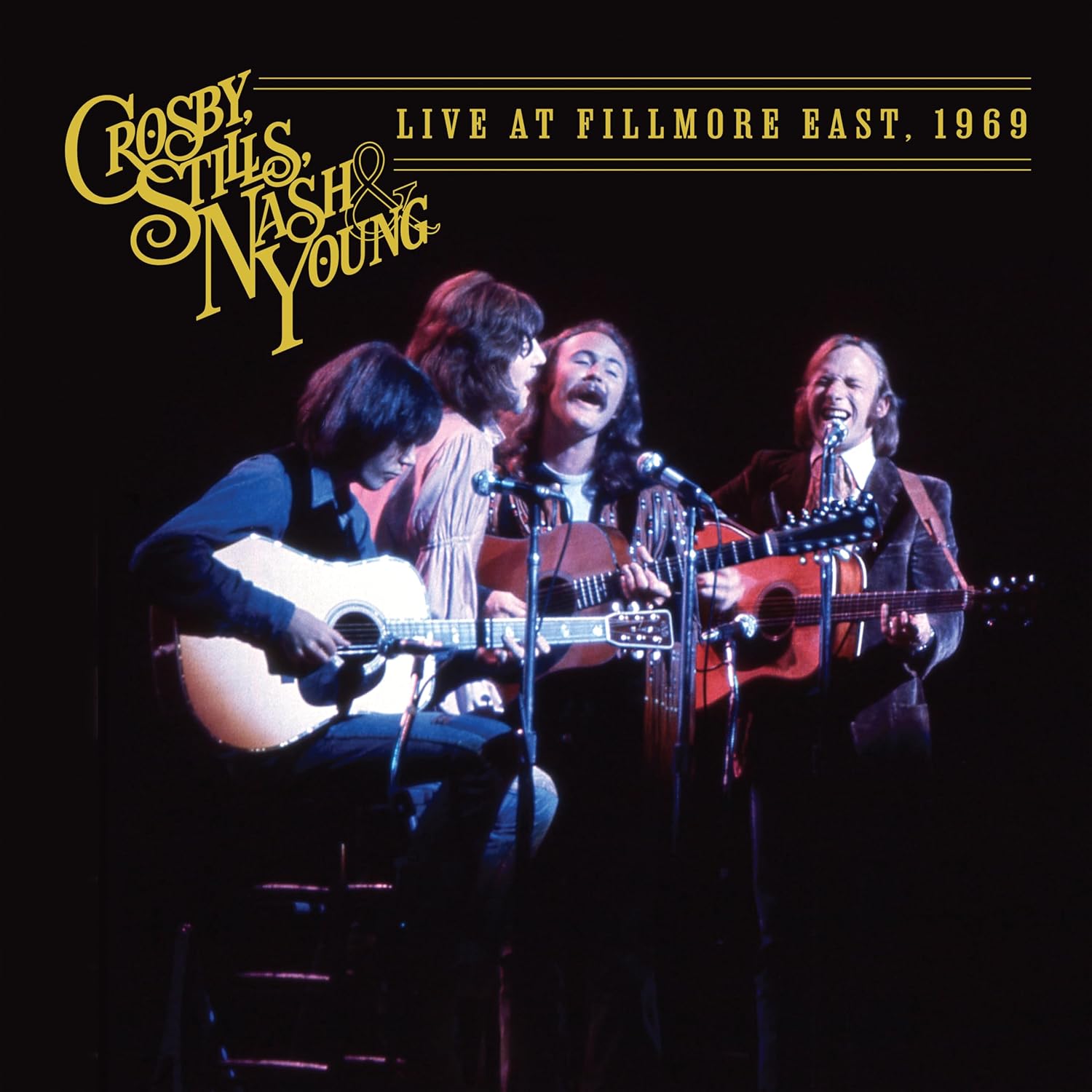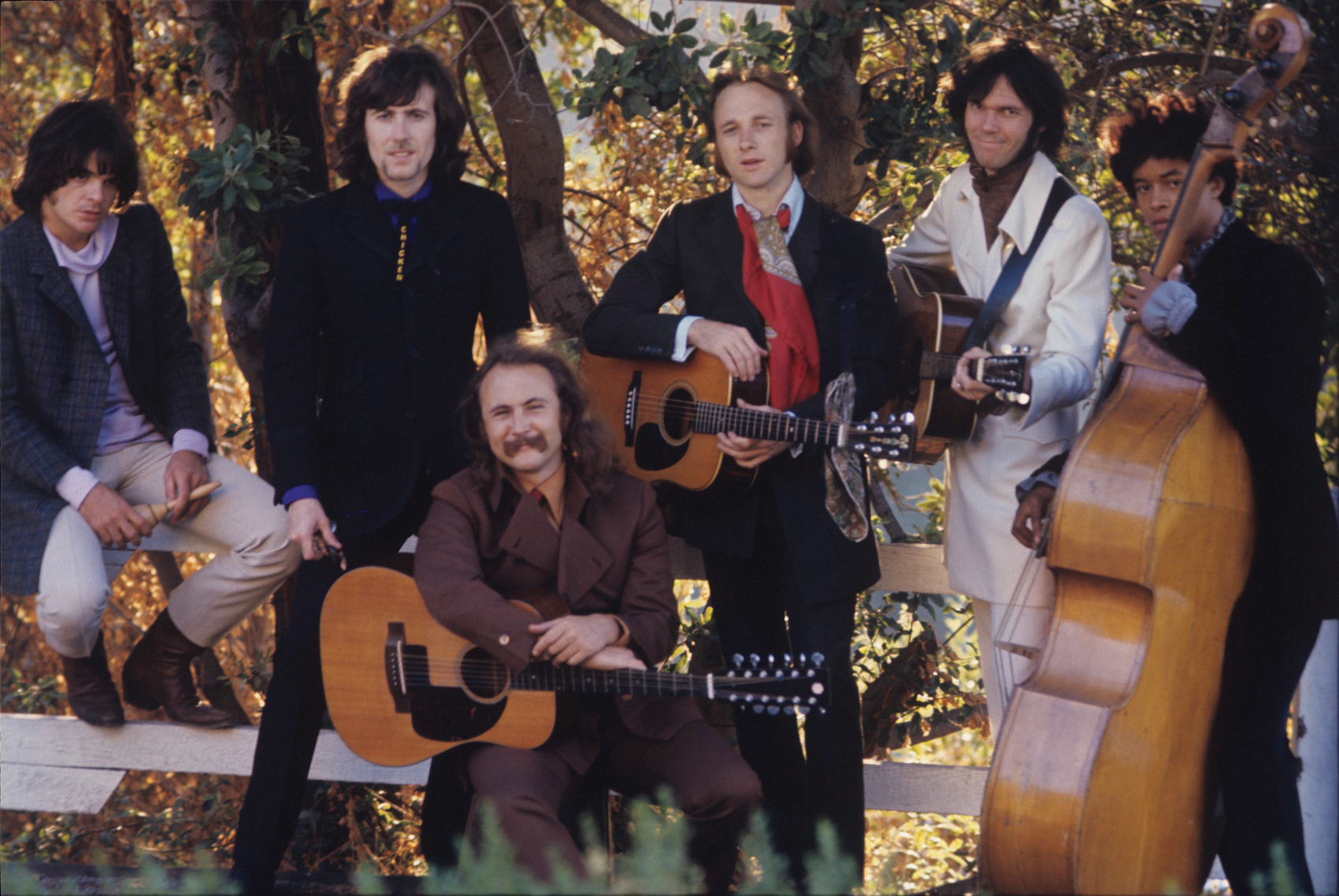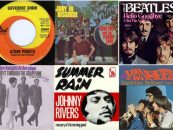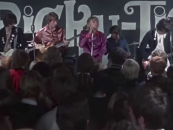 After famously playing their second show at Woodstock in August 1969, David Crosby, Stephen Stills, Graham Nash, and Neil Young spent the rest of the year touring and writing songs for what would become CSNY’s 1970 debut, Déjà Vu. A newly discovered multi-track recording of the band’s September 20, 1969, concert at the historic Fillmore East in New York City captures an early moment from that first tour and was released on October 25, 2024. Live At The Fillmore East, 1969 is available on 2-LPs or 2-CDs in the U.S. here and in the U.K. here. Listen to many of these previously unreleased live versions below.
After famously playing their second show at Woodstock in August 1969, David Crosby, Stephen Stills, Graham Nash, and Neil Young spent the rest of the year touring and writing songs for what would become CSNY’s 1970 debut, Déjà Vu. A newly discovered multi-track recording of the band’s September 20, 1969, concert at the historic Fillmore East in New York City captures an early moment from that first tour and was released on October 25, 2024. Live At The Fillmore East, 1969 is available on 2-LPs or 2-CDs in the U.S. here and in the U.K. here. Listen to many of these previously unreleased live versions below.
The September 10 announcement notes that the four band members were heavily involved in the creation of this never-before-heard live show. Stills and Young compiled and mixed the original eight-track concert recordings with John Hanlon at Sunset Sound Studios in Los Angeles. The audio is AAA lacquer cut for the vinyl release to provide the highest audio fidelity.
What the announcement doesn’t point out is just how young the four musicians were at the time of the concert. Croz, who had turned 28 just days before Woodstock, and Nash, 27, were the “grey beards.” Stills and Young, who had ended their relatively short time together in Buffalo Springfield in ’68, were just 24 and 23, respectively.
Best Classic Bands had reported about the release back in April based on comments that Young had shared. “I was new in the band, having been brought in by Stephen Stills, my Buffalo Springfield band-mate. We didn’t know much material to sing together yet. They had the historic CSN album with tracks created largely by Stills, full of great songs and singing by all members. When we took the stage, CSN would play their favorites along with some brand new songs that would later [become] classics. Some, like ‘Our House,’ were so new that only the writer-singer would perform them.”
Recorded only a month after Woodstock, the September 20 concert was the band’s fourth show in two days at the Fillmore East and featured both acoustic and electric sets. Stills shares they were still figuring things out. “We had no idea how long this was going to last. Or how big it would get,” he says. “All we knew is we had a hit, and we’d better get cracking. These first few concerts would inform the songs to come, but for now we had these and a few holdovers from previous projects. Everything was on the fly. We had been singing the acoustic ones for months to anyone who would listen . . . to an open refrigerator. It’s why the album came so easily. The singing virtually arranged itself—a few inspired ideas but for the most part what came naturally.”
Their lack of experience of experience as a performing quartet and the newness of the material is noticeable when they occasionally forget the words to the songs. But the magic—and those glorious harmonies—shine through.
Stills adds: “Not that there weren’t decades of experience with really great vocal training and organizations under our respective belts. So when we realized we had to tour, like now, we were determined to have some electric music to play. Especially since Neil had come aboard.
“The acoustic part of the show took care of itself, but now that we had equipment and Dallas [Taylor, drums] and Greg [Reeves, bass] and sizable shows to do, we just went for it. What we lacked in finesse, we made up for in enthusiasm…A band on the run. Expecting to fly.”

Nash, Crosby, Stills and Young, with drummer Dallas Taylor (L) and bass guitarist Greg Reeves (R) in August 1969 (Photo © Henry Diltz; used with permission)
The setlist leans heavily on soon-to-be classics from CSN’s self-titled debut, released just four months earlier, with seven tracks including “Suite: Judy Blue Eyes,” “Helplessly Hoping,” and “Long Time Gone” among them. Stills’ “Suite” is still relatively new enough that at one point the audience applauds thinking that it’s over.
The concert also features early versions of two future Déjà Vu tracks. Stills delivers a stunning solo acoustic performance of his introspective ballad “4 + 20,” followed by Nash, alone at the organ, singing “Our House” to its inspiration, Joni Mitchell, who was in the Fillmore audience.
Young’s Everybody Knows This Is Nowhere, released earlier that year, is represented with a jam-filled 16+ minute “Down By The River.”
Related: Our Album Rewind of Déjà Vu
In the acoustic set, Young gave a nod to Buffalo Springfield playing “I’ve Loved Her So Long,” a song he wrote for the group’s final album, 1968’s Last Time Around. Young says, “For me, CSNY was a chance to reunite with Steve Stills and carry on the Buffalo Springfield vibe. Crosby’s great energy was always our catalyst. Graham and Stephen’s vocals, along with David’s and mine, were uplifting every night. Great moments I will never forget.”
The electric set is powerful and intense, highlighted by expansive versions of “Wooden Ships,” “Long Time Gone,” and “Sea Of Madness.” The band closes the show with “Find The Cost Of Freedom,” a new song by Stills that later would be released as the B-side to the protest anthem “Ohio.”
“Hearing the music again after all these years, I can tell how much we loved each other and loved the music that we were creating,” Nash says. “ We were so confident in what we were doing, and you can hear it in this recording. We even joked with each other in the middle of singing a song, and the gentle but spirited way we did the acoustic songs contrasted so much with the enormous, huge sound of the electric set.
We were four people reveling in the different sounds we were producing, quietly singing together on the one hand, then rocking like f**k for the rest of the concert. Our audiences were as pleased as we were by what they said was a ‘concert to remember,’ and I’ve often told the story of our friend Bill Graham pushing $100 bills under the door, trying to entice us to do yet another song. It was only when Neil saw that he’d gotten to $800 that we finally gave up and went back to play another encore, much to the delight of the audience.”
Stills is represented far more than any of the others with eight of the 17 tracks (including one he co-wrote).
Live At The Fillmore East, 1969 LP Tracklist
Acoustic Set
Side One
“Suite: Judy Blue Eyes”
“Blackbird”
“Helplessly Hoping”
“Guinnevere”
“Lady Of The Island”
Side Two
“Go Back Home”
“On The Way Home”
“4 + 20”
“Our House”
“I’ve Loved Her So Long”
“You Don’t Have To Cry”
Electric Set
Side One
“Long Time Gone”
“Wooden Ships”
“Bluebird Revisited”
“Sea Of Madness”
Side Two
“Down By The River”
“Find The Cost Of Freedom”
Less than a year later, Crosby, Stills, Nash & Young returned to the Fillmore from June 2-7, 1970. Many of the performances at those shows were released on the band’s 1971 double live album, 4 Way Street.






6 Comments so far
Jump into a conversationWhether or not Neil Young had written “I’ve Loved Her So Long” for Buffalo Springfield’s final album, it didn’t appear there, but it was present on his first solo album “Neil Young.”
Neil Young’s addition to the band was not a good move. His whiny, irritating voice doesn’t blend with the others, and he never got into the “band” concept. He’s too much of a loner. (Can you tell that I’m not a Neil Young’s music? Love his politics, but can’t stand his singing.) I loved CSN, but adding the Y didn’t make for any great music, at least in my book.
love Neil Young’s voice, love his singing. Thought he added alot to the band, made them better.
This should be an interesting compare/contrast with their ’71 release “Four Way Street”, recorded about nine months later but with a different rhythm section. And agree with V2787, the addition of Young was, on balance, unfortunate. It was also something that I believe was encouraged by both management and record label execs.
Wonderful. And Graham Nash still has his Manchester accent:)
Without Neil Young we wouldn’t have “Déjà Vu”.
A real masterpeace! A record that’s in my collection for more than 55 years now and it’s still my favorite record of all.